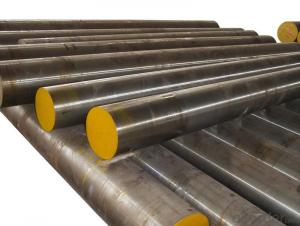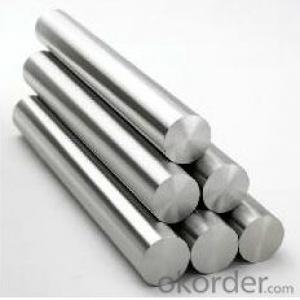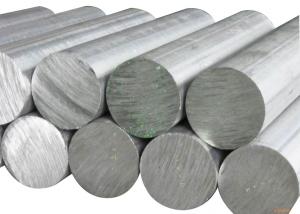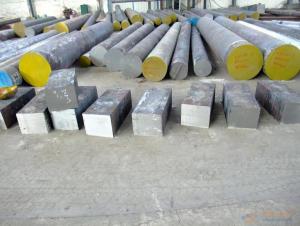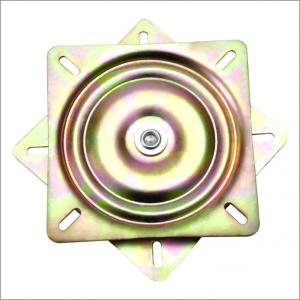Hot Rolled Spring Steel Bar 60Si2CrA with High Quality for Construction
- Loading Port:
- China main port
- Payment Terms:
- TT or LC
- Min Order Qty:
- 25000 m.t.
- Supply Capability:
- 200000 m.t./month
OKorder Service Pledge
OKorder Financial Service
You Might Also Like
Specification of Hot Rolled Spring Steel Bar 60Si2CrA with High Quality for Construction:
-Material: 60Si2CrA
-Standard: GB/T 1222-1984
-Type: Spring Steel
Corresponding Steel Grade for Reference:
CHN, GB | JPN, JIS | GER, DIN | GBR, BS |
60Si2CrA | SWOSC-V | 67SiCr5 | 685H57 |
USA, AISI/SAE/ASTM | ISO | ||
9254 | 55SiCr63 |
Chemical Composition:
C | Si | Mn | S |
0.52~0.60 | 1.5~2.00 | 0.60~0.90 | ≤0.035 |
P | Cr | Ni | Cu |
≤0.035 | ≤0.35 | ≤0.35 | ≤0.25 |
Mechanical Properties:
-Tensile Strength σb (MPa): ≥1274(130)
-Yield Strength σs (MPa): ≥1176(120)
-Elongation δ10(%): ≥6
-Percentage reduction of area: ψ (%): ≥30
-Hardness:
1, Hot rolled, ≤302HB
2, Cold drawn + Heat treatment: ≤321HB
-Norm of heat treatment: quenching 870℃±20℃
-Micro structure: Tempered troostite.
Usage/Applications of Hot Rolled Spring Steel Bar 60Si2CrA with High Quality for Construction:
-Compared with Si-Mn spring steel under the similar condition of plasticity, 60Si2CrA have higher tensile strength, yield strength and hardenability.
-60Si2CrA is applied for producing springs with working temperature below 300~500℃. This type of spring can bear high stress, for example, governor spring, turbine steam seal spring, etc…
Packaging & Delivery of Hot Rolled Spring Steel Bar 60Si2CrA with High Quality for Construction:
-Packing Detail:
1, The products can be packed in bundles by steel wires.
2, The weight of each bundle no exceed normally 3 tons
-Marks: there are two types of marks. One is tag mark, for showing customers the specifications of products, company name and logo and other information required by customers. Other one is color marks. They are used to make the products more evident so that it’s easy for customers to distinguish them from other products at destination port.
-Delivery Detail: 30~45 working days after receive buyer’s T.T. or L/C.
Transportation:
-The products can be delivered by bulk vessel or by container. As for container, products with the length of 6m will be loaded in 20’ container, with 9m or 12m, in 40’ container.
-The maximum quantity of loading of container is 25 tons.
-The products are usually transported to the nearest port from the production place.
Payment:
-Invoicing on theoretical weight or actual weight as customer’s request.
-FOB, CFR or CIF.
-Terms of payment: T.T. or L/C at sight.
FAQ:
Q1: How soon can we receive the product after purchase?
A1: Within three days of placing an order, we will begin production. The specific shipping date is dependent upon international and government factors, but is typically 7 to 10 workdays.
Q2: What makes stainless steel stainless?
A2: Stainless steel must contain at least 10.5 % chromium. It is this element that reacts with the oxygen in the air to form a complex chrome-oxide surface layer that is invisible but strong enough to prevent further oxygen from "staining" (rusting) the surface. Higher levels of chromium and the addition of other alloying elements such as nickel and molybdenum enhance this surface layer and improve the corrosion resistance of the stainless material.
Q3: Can stainless steel rust?
A3: Stainless does not "rust" as you think of regular steel rusting with a red oxide on the surface that flakes off. If you see red rust it is probably due to some iron particles that have contaminated the surface of the stainless steel and it is these iron particles that are rusting. Look at the source of the rusting and see if you can remove it from the surface.
Images:
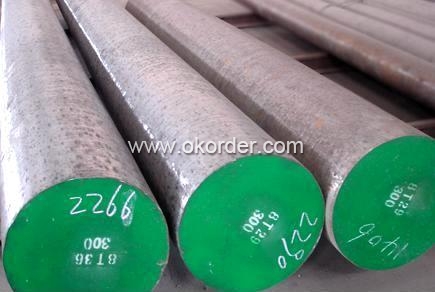
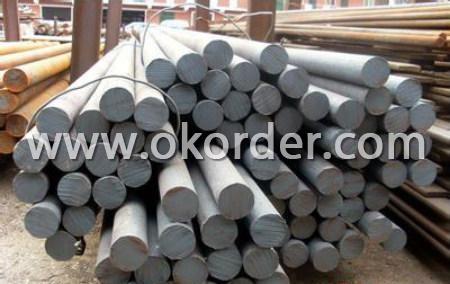
- Q:What are the properties of corrosion-resistant tool steel?
- Corrosion-resistant tool steel possesses properties such as high hardness, excellent wear resistance, good toughness, and resistance to corrosion and oxidation. It is designed to withstand exposure to harsh environments, chemicals, and moisture, making it ideal for applications where resistance to corrosion is crucial, such as in marine environments or chemical processing industries.
- Q:How is precipitation-hardening steel used in the aerospace industry?
- Precipitation-hardening steel is extensively used in the aerospace industry due to its exceptional strength-to-weight ratio and high corrosion resistance. It is employed in critical components such as aircraft structures, landing gears, turbine blades, and fasteners. The steel's unique property of being able to strengthen through a precipitation process allows for the manufacturing of lightweight and durable parts, resulting in improved fuel efficiency, enhanced performance, and increased safety in aircraft operations.
- Q:How is magnetic alloy steel used in the production of magnetic components?
- Magnetic alloy steel is used in the production of magnetic components due to its high magnetic permeability and excellent magnetic properties. It is commonly utilized in manufacturing various magnetic components such as cores, stators, rotors, and transformers. The alloy's magnetic properties allow for efficient magnetization and demagnetization, making it suitable for applications where strong magnetic fields are required. Additionally, magnetic alloy steel is often used in electrical motors, generators, and magnetic sensors, contributing to their overall performance and reliability.
- Q:What are the different types of tool steel?
- There are several different types of tool steel, including high-speed steel, cold work steel, hot work steel, and plastic mold steel. Each type of tool steel is specifically designed for different applications and has unique properties that make it suitable for specific tasks.
- Q:How does special steel perform in high-temperature mechanical fatigue conditions?
- Special steel performs well in high-temperature mechanical fatigue conditions due to its unique composition and properties. It exhibits excellent strength, toughness, and heat resistance, enabling it to withstand cyclic loading and high temperatures without experiencing significant degradation or failure. The special steel's exceptional performance in such conditions makes it an ideal choice for applications that involve continuous exposure to elevated temperatures and mechanical stresses, ensuring long-term reliability and durability.
- Q:How does special steel perform in terms of wear resistance?
- Special steel is known for its exceptional wear resistance. Due to its unique composition and heat treatment, it exhibits a higher level of hardness and toughness compared to regular steel. This enables it to withstand abrasion, impact, and other forms of wear, making it highly suitable for applications where durability and longevity are crucial, such as in industrial machinery, cutting tools, and automotive components.
- Q:Can special steel be used in the manufacturing of precision instruments?
- Indeed, precision instruments can benefit from the utilization of special steel. Special steel encompasses a range of steel types that have been purposefully crafted and processed to possess specific attributes, such as heightened strength, hardness, resistance to corrosion, and thermal stability. These unique qualities render special steel highly suitable for applications necessitating precision and accuracy, such as precision instrument manufacturing. Precision instruments, such as surgical tools, measuring devices, optical instruments, and scientific equipment, necessitate materials capable of retaining dimensional stability and enduring extreme conditions. Special steels, such as stainless steel, tool steel, and high-speed steel, provide exceptional mechanical properties, including remarkable tensile strength, resistance to wear, and dimensional stability. Consequently, these kinds of steel are well-suited for the production of precision instruments. Moreover, special steel can be engineered to possess specific characteristics, such as low magnetic permeability or excellent resistance to temperature fluctuations. These attributes prove particularly vital in precision instruments, as magnetic interference or temperature variations have the potential to impact their performance. To summarize, special steel can indeed be employed in the manufacturing of precision instruments due to its exceptional mechanical properties, dimensional stability, and ability to withstand harsh conditions. Its versatility enables the production of precision instruments of superior quality, fulfilling the stringent requirements of various industries, including the medical, scientific, and engineering sectors.
- Q:How does special steel contribute to the manufacturing of automotive engine components?
- The manufacturing of automotive engine components heavily relies on special steel to enhance their strength, durability, and performance. Special steel possesses unique properties that make it suitable for critical engine parts like crankshafts, camshafts, connecting rods, valve springs, and cylinder heads. The exceptional strength of special steel is one of its primary advantages in automotive engine components. Engine parts made from special steel can withstand high stress, heavy loads, and extreme temperatures without experiencing deformation or failure. This strength ensures that the engine operates efficiently and reliably, even under demanding conditions. Furthermore, special steel offers superior durability, which is crucial for the longevity and performance of engine components. Its resistance to wear, corrosion, and fatigue ensures that the engine parts maintain their functionality for an extended period. This durability translates into increased lifespan and reduced maintenance requirements for the engine, resulting in higher customer satisfaction and lower costs for vehicle owners. The use of special steel in automotive engine components also contributes to improved performance. Special steel allows for the creation of lightweight components, reducing the overall weight of the engine and enhancing fuel efficiency. Additionally, the high precision and dimensional accuracy achievable with special steel manufacturing processes result in better engine performance, reduced friction, and improved power output. Moreover, special steel exhibits excellent machinability, simplifying the manufacturing process of engine components. Its ability to be easily formed, cut, and shaped enables the production of complex designs and intricate features, leading to enhanced efficiency and performance in the final product. In conclusion, special steel plays a vital role in the manufacturing of automotive engine components due to its exceptional strength, durability, and performance. Its usage results in engines that are more reliable, efficient, and long-lasting, ultimately contributing to the overall quality and satisfaction of vehicles.
- Q:What are the specific requirements for special steel used in the marine shafting industry?
- The marine shafting industry has specific requirements for special steel, which are as follows: 1. Corrosion Resistance: The steel used in marine shafting must possess a high resistance to corrosion, as it is exposed to harsh marine conditions. It should be able to withstand saltwater, humidity, and other corrosive elements without deteriorating. 2. Strength and Toughness: Marine shafting steel should have high strength and toughness to withstand the heavy loads and vibrations experienced in marine operations. It should be able to handle continuous stress and dynamic loads without failing or deforming. 3. Fatigue Resistance: The steel used in marine shafting should have excellent fatigue resistance to endure the cyclical loading during operation. It should be able to withstand millions of load cycles without developing cracks or fractures. 4. Dimensional Stability: Special steel used in marine shafting must maintain dimensional stability to ensure accurate alignment and fit within the machinery. It should have minimal dimensional changes under varying temperature and humidity conditions to preserve the integrity of the shaft system. 5. Machinability: The steel used in marine shafting must be easily machinable to create intricate shapes, such as propeller shafts and couplings. This allows for efficient manufacturing and maintenance of the shafting components. 6. Non-Magnetic Properties: Special steel used in marine shafting should have low magnetic permeability to avoid interfering with sensitive navigation and communication equipment. Non-magnetic properties minimize the risk of compass errors and electromagnetic interference. 7. Certification and Compliance: The steel used in marine shafting should meet specific industry standards and certifications, such as those established by classification societies like the American Bureau of Shipping (ABS) or the International Association of Classification Societies (IACS). These certifications ensure the steel's quality, performance, and compliance with safety regulations. By meeting these specific requirements, the special steel used in marine shafting guarantees reliable performance, durability, and safety in marine applications.
- Q:What are the specific requirements for special steel used in the marine propeller industry?
- To ensure optimal performance and durability in harsh marine environments, the marine propeller industry requires special steel that meets specific requirements. These requirements include the following: 1. Corrosion Resistance: Special steel must resist corrosion caused by constant exposure to saltwater. This prevents rust formation and maintains the propeller's integrity over time. 2. Strength and Toughness: The steel must possess high strength and toughness to withstand mechanical stresses and impacts, especially in rough sea conditions, without deforming or failing. 3. Fatigue Resistance: The steel should have excellent fatigue resistance to endure millions of load cycles without developing cracks or fractures. 4. Weldability: The steel must be easily weldable to ensure strong and reliable joints when manufacturing segmented propellers. 5. Heat Resistance: The steel needs to withstand significant heat generated by friction and propulsion forces to prevent deformation or loss of mechanical properties at high temperatures. 6. Machinability: Special steel should be easily machinable to allow for precise shaping and finishing of complex propeller blade designs. 7. Non-Magnetic Properties: To minimize interference with magnetic navigation systems and sensors used in modern ships, the steel should have low magnetic permeability. By meeting these specific requirements, the special steel used in the marine propeller industry can withstand seawater's challenging conditions, provide efficient propulsion, and maintain its structural integrity throughout the propeller's lifespan.
1. Manufacturer Overview |
|
|---|---|
| Location | |
| Year Established | |
| Annual Output Value | |
| Main Markets | |
| Company Certifications | |
2. Manufacturer Certificates |
|
|---|---|
| a) Certification Name | |
| Range | |
| Reference | |
| Validity Period | |
3. Manufacturer Capability |
|
|---|---|
| a)Trade Capacity | |
| Nearest Port | |
| Export Percentage | |
| No.of Employees in Trade Department | |
| Language Spoken: | |
| b)Factory Information | |
| Factory Size: | |
| No. of Production Lines | |
| Contract Manufacturing | |
| Product Price Range | |
Send your message to us
Hot Rolled Spring Steel Bar 60Si2CrA with High Quality for Construction
- Loading Port:
- China main port
- Payment Terms:
- TT or LC
- Min Order Qty:
- 25000 m.t.
- Supply Capability:
- 200000 m.t./month
OKorder Service Pledge
OKorder Financial Service
Similar products
New products
Hot products
Related keywords
